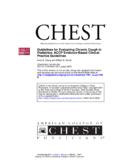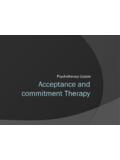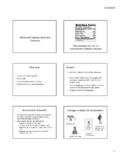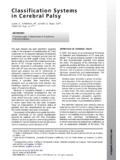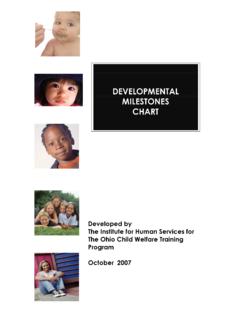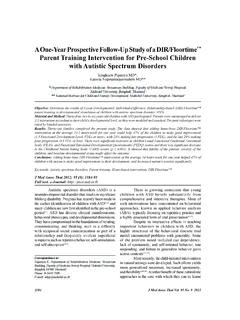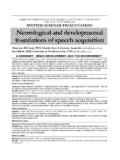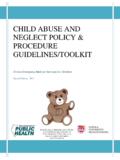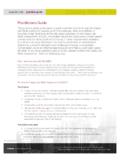Transcription of Pediatric and Infant Neurologic Examination
1 Pediatric and Infant Neurologic Examination William Hills, MD History: -As with adults, careful and accurate Neurologic history is the most important part -Discussing onset of symptoms in chronological order is often helpful -Other characteristics: - Frequency - Duration - Static, progressing, or improving - Acute, subacute, or chronic -ROS -Birth history Gestational age, complications during pregnancy (including infections), maternal drug and alcohol use, Apgar scores, problems during delivery meconium, and feeding difficulties. PMHX: immunization status, accidents, chronic medical problems; Espec pertinent to szs head trauma, febrile szs, status epilepticus, meningitis Medications (when discussing szs, include previous AEDs and response) Developmental milestones (may use the Denver II) Family history: epilepsy, neurocutaneous syndromes, migraines, neurodegenerative disorders, etc General Physical 1.
2 Height, weight, blood pressure, and head circumference. -Rule of thumb for head circumference is the 3 & 9 rule. AGE head circumference newborn 35 cm 3 month 40 cm 9 month 45 cm 3 yo 50 cm 9 yo 55 cm 2. General appearance, including dysmorphology. 3. Skin exam: neurocutaneous lesions ( ash leaf spots (TS), cafe au lait spots (NF), angiomas (SW), axillary freckling (?), adenoma sebaceum (?), or shagreen patches (?). 4. Location of the hair whorl (can signify presence of cerebral malformations) and appearance of palmar creases (which genetic syndrome?) 5. Quality of scalp hair, eyebrows, and nails. Friable, kinky hair may signify Menkes kinky hair disease that is associated with mental retardation and optic atrophy.)
3 6. Exam of the midline of the back and neck for sacral dimples, tufts of hair, or other signs of spinal dysraphism. 7. Comparison of thumbnail sizes and their convexity. Abnormalities may signify a growth disturbance, which may be a sign of hemiparesis. 8. Presence of unusual body odor, which is present in some inborn errors of metabolism. 9. Hepatosplenomegaly . Neurologic Examination of the Child. General tips 1. Use items such as a tennis ball, small toys (including a toy car), bell, and an object that will attract the child's attention (like a pinwheel). 2. Do not wear a white coat. 3. Postpone uncomfortable tasks until the end, such as head circumference, funduscopy, corneal and gag reflexes, and sensory testing.
4 4. Make the most of every opportunity to examine the child. See how he or she plays, taking into account handedness and motor deficits. 5. Examine the younger child in the parent's lap. Be patient and wait for the child the make the first move before touching him or her. Give the child a toy to establish rapport. 1) The Skull - microcephaly, macrocephaly, craniosynostosis (or premature closure of the cranial sutures) - Prominence of scalp veins = increased ICP. - Flattening of the occiput = hypotonia - Prominence of the occiput may signify Dandy-Walker syndrome - Ridging of the cranial sutures--sign of craniosynostosis - Percussion of the skull showing areas of tenderness osteomyelitis - Macewen (cracked pot) sign = sutures are separated, may indicate increased ICP - Anterior fontanelle is bulging (see how it changes based on Infant s position while sitting up or laying down, and while crying or content) = increased ICP - Auscultate the skull using the bell of the stethoscope in six locations for bruits: globes, the temporal fossae, and retroauricular or mastoid areas o Intracranial bruits are heard in many cases of angiomas, often accompanied by a palpable thrill.
5 They can also be heard in anemia, thyrotoxicosis, and meningitis. 2) Cranial nerves CN I (olfactory) appears at 5 to 7 months of age. CN II (optic) can be tested through various means -Funduscopic exam for appearance of the optic disk, macula, and retina -Visual acuity - Vision chart - In a younger child, offer toys of various sizes - Optokinetic nystagmus o Rotate a striped drum or draw a strip of cloth with black and white squares in front of the eyes o Optokinetic nystagmus can be elicited starting 4 to 6 months of age o Confirms cortical vision o Supports the integrity of the frontal/parietal lobes and visual fields. -Visual fields in children less than a year of age o Have one examiner attract the attention of the child to a toy/shiny metal object after which another examiner in back of the child brings another toy into the field of vision, noting the location at which the child turns his or her head towards this second toy -The blink reflex appears at about 3 to 4 months.
6 Present in about 50% at 5 months and 100% of children at 12 months. CN III, IV, and VI (oculomotor, trochlear, abducens) (LR6SO4). -extraocular movements -pupillary size and reaction to light. Pupils may be large and not responsive to light in babies earlier than 30 weeks -The Doll's eyes phenomenon can also be used to assess extraocular movements in a comatose patient with an intact brainstem. -In conscious patients, the cortical input overrides the Doll's eyes phenomenon. -cold calorics. In order to do this test, 5 mL of ice water is squirted into the external ear canal in comatose patients or mL in alert, awake patients, and the action of the eyes are noted. -There are three possible responses to this test.
7 1) comatose patient with an intact brainstem, the eyes move in the direction of the stimulus. 2) alert, awake patients, there is nystagmus with the quick component in the opposite direction of the stimulus. 3) without a functioning brainstem, there is no movement of the eyes when cold calorics are performed. **One needs to remember that cold calorics test vestibular function (CN VIII). CN V (trigeminal) -sensation of the face. -temporalis and masseter muscles can test the motor roots of this cranial nerve. --corneal reflex also checks the ophthalmic branch of CN V. CN VII (facial nerve) -facial asymmetry. -Taste in the anterior two-thirds of the tongue is innervated by the chorda tympani branch of VII, and can be checked by applying salt or sugar solutions by cotton-stick applicators.
8 CN VIII (auditory) cochlear and vestibular function can be tested by the child's response to a bell or by recalling a whispered word or number. Noting the eye movements after turning the Infant several times in a clockwise and counterclockwise direction can check vestibular function. CN IX, X (glossopharyngeal, vagus) -uvula and palate. -If there is a vagal nerve problem, the uvula will deviate toward the unaffected side, and the palate will move away from the affected side. -The gag reflex actually tests parts of IX and X --IX is the afferent sensory limb (sensory to the back of the pharynx) --X controls the muscles of the pharynx and elevation of the palate. CN XI (spinal accessory) -turn his/her head against resistance, sternocleidomastoid muscle.
9 CN XII (hypoglossal) -tongue deviates toward the affected side. Motor System Observing the child's posture and simple maneuvers such as retrieving a ball or running outside the Examination room can check motor integrity. The following grading system can be used for assessing muscle strength: 0 - No muscle contraction 1 - Flicker or trace of contraction 2 - Active movement without gravity 3 - Active movement against gravity 4 - Active movement against gravity and resistance 5 - Normal strength (for age, keeping in mind that you as the examiner may be stronger) pronator sign - sensitive test to assess the strength for the upper Barr sign. having the child keep both knees at right angles while lying prone. Strength of the flexors of the knee Cerebellar function how a child reaches for and manipulates toys can check for coordination.
10 FFM, FTN, RAM, or rapid tapping of the foot can assess for dysdiadochokinesia Romberg test - test of proprioception (dorsal columns). Sensory -pinprick, light touch, position, and vibration sense -Object discrimination, which tests for higher cortical functions, can be done using coins, paper clips, or rubber bands. Reflexes. Jaw jerk (CN V) biceps (C5-6) triceps (C6-8) brachioradialis (C5-6), patellar (L2-4) ankle (S1-2). Babinski's sign - pyramidal tract dysfunction + Babinski's sign = dorsiflexion of the great toe and fanning of the toes. Can be normal up to 1 year of age so symmetry is the important feature to look at below 1 year. May be seen after a seizure. Clonus - maintaining dorsiflexion of the foot.


